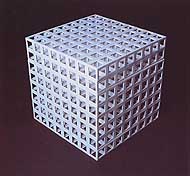|
Top ceramic artists take a final bow
By ROBERT YELLIN
for The Japan Times, June 12, 1999
|

|
|
Kamei Yoichiro's
"Little Receptacle"
won this year's
Asahi Grand Prix.
|
|
SEPTEMBER 2001
The 39th Asahi Ceramic Exhibition (2001) is touring Japan now and offers a chance to see a wide range of ceramic styles. More ambitious than most juried exhibits, the Asahi often gives its Grand Prix award to up-and-coming younger ceramists. This year Kamei Yoichiro was selected for his work "Lattice Receptacle." Looking like an architect's model for a new high-rise, the work is a cube that reveals more about technique than vision.
In fact, that appears to be the case with most of the prize-winning works, which lean toward small-segmented works, with white a favored color.
The judges are all seasoned potters, and one art columnist, who had to work through 588 submitted works to narrow them down to the 109 selected pieces.
The Japan Times: Sept. 12, 2001
(C) All rights reserved
JULY 18th, 2001
The 38th Asahi Ceramic Art Exhibition's grand prix-winning work looks as if the top is going to snap off at any moment and destroy the piece. Yet it defies gravity, frozen in time by fire.
The work, by Iwate's Izumida Yukinari, is made of rough, beige clay with cracks, fissures and coarse edges that complement the soft curve of the base and the edgy, brittle top. It has won Izumida a place among an illustrious group of past Asahi award-winners that includes Kato Kiyoyuki, Suzuki Goro, Kuriki Tatsutsuke and Yoshikawa Masamichi. One thing that sets the Asahi apart from other large exhibitions, such as the Japan Traditional Arts and Crafts Exhibition or the Japan Ceramic Exhibition, is that it doesn't segregate the works into different group classifications: sculpture here, functional there. It mixes all ceramic genres in one bowl.
A seven-member jury presided over the two-day selection process. It was headed by Suzuki Osamu, who sadly passed away not long after. Suzuki was a co-founder of the influential postwar Kyoto ceramic group Sodeisha, and first served as an Asahi juror in 1985. Other jurors included four ceramic artists, one museum head curator and an art journalist. The jurors selected 96 works from among 679 submissions, 10 of which were awarded prizes.
To be accepted for this show is one way to get a career going. It's interesting to note that among the 583 people who submitted work, the largest age group fell among those in their 20s. Izumida is in his 30s. The exhibition has been touring Japan for a year and is now on its last stop -- your last chance to catch it this time around.
38th Asahi Ceramic Art Exhibition, until July 22 at Meguro Museum of Art, (03) 3714-1201
The Japan Times: July 18, 2001
(C) All rights reserved
1999 Asahi Competition
The 36th Asahi Ceramic Art Exhibition finishes a 10-month tour of Japan in Tokyo at the Meguro Museum of Art starting today until July 18. A total of 681 pieces were submitted, with only 109 works chosen. The judges include some top potters, such as Ryoji Koie, Ogawa Machiko, Suzuki Osamu and Kato Kiyoyuki.
Balancing itself between functional and sculptural forms, the Asahi tries to focus on up-and-coming potters and doesn't invite established potters to exhibit.
This year's grand prize winner is Okada Hideaki for his bowl with 63 spiral sticks protruding out of the bowl's rim. An interesting piece, but it seems to be trying to do too much in too little space. Past winners of the Asahi grand prize include Suzuki Goro (1966), Kato Yasuhide (1968, '74), Kuriki Tatsusuke (1969, '71) and Tsukamoto Haruhiko (1996).
The Japan Times: June 12, 1999
(C) All rights reserved
LEARN MORE ABOUT JAPAN'S AWARD SCENE
For much more, please visit the PHOTO TOURS page. It includes links to other wonderful photo tours, including prior Japan Ceramic Society events, Living National Treasures, Contemporary Artists, How the Japanese Rank Their Potters, plus other visual resources.
Awards Index -- Our Entire Lineup of Online Photo Tours
.
|